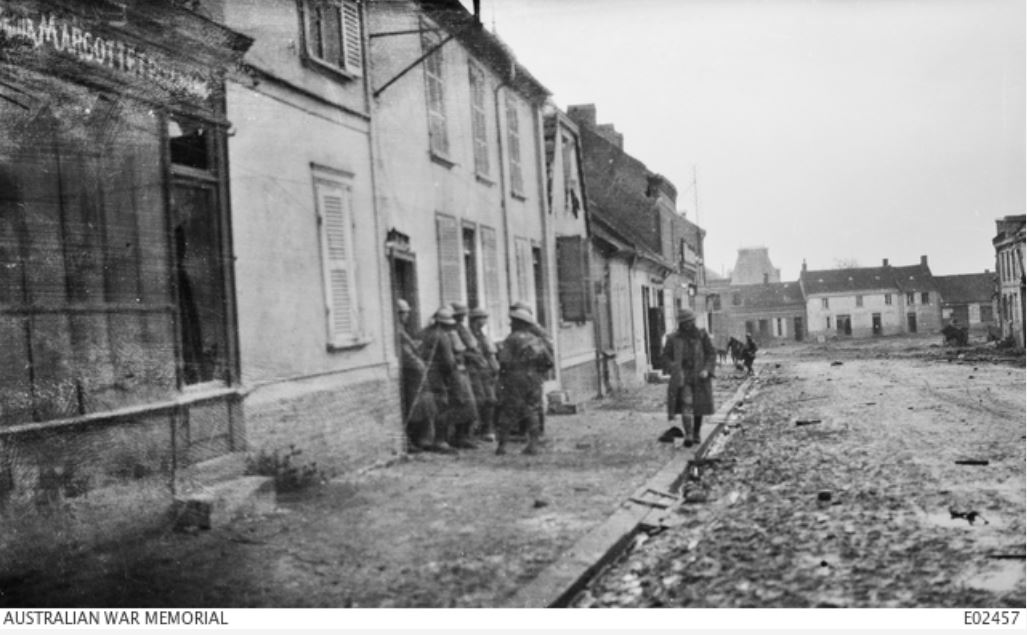Difference between revisions of "33rd Battalion"
From Our Contribution
(→Battalion Personnel) |
|||
| Line 62: | Line 62: | ||
==Notes== | ==Notes== | ||
Content for the history and honours sections has come from a combination of Wikipedia and the Australian War Memorial websites. | Content for the history and honours sections has come from a combination of Wikipedia and the Australian War Memorial websites. | ||
| + | |||
| + | For further details about this battalion's participation in the war, see:<br> | ||
| + | * ''Never A Backward Step - A History of the 33rd Battalion AIF'', by John Edwards | ||
<references /> | <references /> | ||
Latest revision as of 15:30, 18 February 2022
 Shoulder patch | |
 Villers-Bretonneux Battalion HQs AWM photo E02457 | |
Contents
Brief History
The 33rd Battalion was formed in northern New South Wales in January 1916. The majority of the battalion's personnel came from the New England region, and as a result the 33rd Battalion came to be known unofficially as "New England's Own". After initial training in Armidale NSW, the battalion moved to Maitland, where they concentrated with the rest of the troops forming the 9th Brigade. On 3 May 1916, the battalion entrained for Sydney, where they embarked upon the HMAT A74 Marathon and sailed the following day. Although intended for Egypt, enroute the battalion was redirected to England, arriving on 9 Jul 1916.
Following five months training in England they boarded HMPS Mona's Queen for France, arriving in Le Have in late November 1916.
This first battle came at Messines on 7 Jun 1917 where the 33rd, along with the rest of the 9th Brigade, led the 3rd Division's assault. Despite suffering around 200 casualties from friendly gas-shells that had dropped short, the battalion attacked at the appointed hour and, after skirting the large crater that a mine had caused, secured their objective. They were then used in a support role at Broodseinde, but were thrown into the assault on Passchendaele in a sector thick with fortified pillboxes. Eventually heavy rain created conditions in which further attacks were impossible and those that survived withdrew.
In 1918 they hurriedly entered the fray in defence of Amiens when the Germans launched a major assault in the Somme region. They participated in the Australian assault on Hangard Wood and the defeat of the German advance near Villers-Bretonneux. In late April 1918 they were reinforced with men from the 36th Battalion which had been disbanded along wit the 47th and 52nd Battalions.
During the Hundred Days Offensive that followed they fought at Accroche Wood, and in attacks on the Hindenburg Line before enjoying a three week spell out of the line. On their return they fought with American troops to take Bellecourt in late September, fought off a German attack near Gillemont Farm, and carried out mopping up operations near Bony. When the Armistice came they were in billets in Citerne.
Finally in May 1919 the battalion was disbanded. During the course of the war, the 33rd Battalion lost 451 men killed and 2,052 wounded.
Battalion Personnel
- † Ernest John Coles 11 Nov 1916 - 7 Jun 1917 (KIA Messines)
- James Henry Davidson 12 Jan - 21 Nov 1916
- † Thomas Hesketh 14 Nov 1916 - 24 Aug 1918 (KIA aerial bomb)
Battle Honours
- Messines 1917
- Ypres 1917
- Polygon Wood
- Broodseinde
- Poelcappelle
- Passchendaele
- Somme 1918
- Ancre 1918
- Amiens
- Albert 1918
- Mont St Quentin
- Hindenburg Line
- St Quentin Canal
- France and Flanders 1916–18
Individual Honours
- 2 Victoria Crosses (LCpl John Carroll and Pte George Cartwright)
- 1 Commander of the Order of St Michael and St George
- 6 Distinguished Service Order, and 1 bar
- 1 Member of the British Empire
- 22 Military Crosses and 1 bar
- 19 Distinguished Conduct Medals and 1 bar
- 8 Distinguished Service Medals
- 78 Military Medals and 3 bars, with 1 second bar
- 12 Meritorious Service Medals
- 25 Mentioned in Despatches
- 9 foreign awards
Notes
Content for the history and honours sections has come from a combination of Wikipedia and the Australian War Memorial websites.
For further details about this battalion's participation in the war, see:
- Never A Backward Step - A History of the 33rd Battalion AIF, by John Edwards